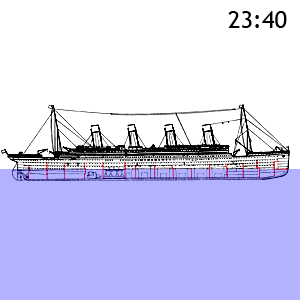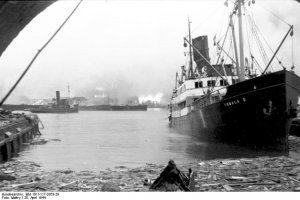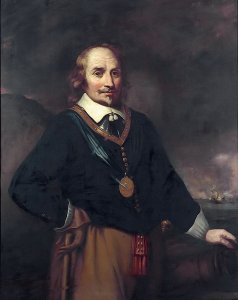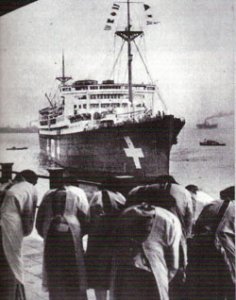Today in Naval History - Naval / Maritime Events in History
11th of April
please use the following link and you will find the details and all events of this day ..... in the following you will find some of the events
1693 – Launch of HMS Sussex, an 80-gun third-rate ship of the line of the English Royal Navy, lost in a severe storm on 1 March 1694 off Gibraltar.
HMS Sussex was an 80-gun third-rate ship of the line of the English Royal Navy, lost in a severe storm on 1 March 1694 off Gibraltar. On board were possibly 10 tons of gold coins. This could now be worth more than $500 million, including the bullion and antiquity values, making it one of the most valuable wrecks ever.

And the wonderful model built by our member Ramon, alias @ramonolivenza

1796 - Royal Navy HMS Révolutionnaire captured Gracieuse, a 32-gun Charmante-class frigate off Île d'Yeu and brought her into British service as HMS Unite.
Gracieuse was a 32-gun Charmante-class frigate of the French Navy. Renamed to Unité in 1793, she took part in the French Revolutionary Wars. The Royal Navy captured her in 1796 off Île d'Yeu and brought her into British service as HMS Unite. She was sold in 1802

1796 - french 80-gun ship of the line Ça Ira, ex Couronne. was destroyed in an accidental fire
The Couronne was an 80-gun ship of the line of the French Navy.

Model of Couronne, on display at the Château de Brest.
1809 - Beginning of the Battle of the Basque Roads, also known as the Battle of Aix Roads (French: Bataille de l'île d'Aix)
was a major naval battle of the Napoleonic Wars, fought in the narrow Basque Roads at the mouth of the Charente River on the Biscay coast of France.
The Battle of the Basque Roads, also known as the Battle of Aix Roads (French: Bataille de l'île d'Aix, also Affaire des brûlots, rarely Bataille de la rade des Basques) was a major naval battle of the Napoleonic Wars, fought in the narrow Basque Roads at the mouth of the Charente River on the Biscay coast of France. The battle, which lasted from 11–24 April 1809, was unusual in that it pitted a hastily-assembled squadron of small and unorthodox British Royal Navy warships against the main strength of the French Atlantic Fleet, the circumstances dictated by the cramped, shallow coastal waters in which the battle was fought. The battle is also notorious for its controversial political aftermath in both Britain and France.
In February 1809 the French Atlantic Fleet, blockaded in Brest on the Breton coast by the British Channel Fleet, attempted to break out into the Atlantic and reinforce the garrison of Martinique. Sighted and chased by British blockade squadrons, the French were unable to escape the Bay of Biscay and eventually anchored in the Basque Roads, near the naval base of Rochefort. There they were kept under observation during March by the British fleet under the dour Admiral Lord Gambier. The Admiralty, desiring an attack on the French fleet, ordered Lord Cochrane, an outspoken and popular junior captain, to lead an attack, over the objections of a number of senior officers. Cochrane organised an inshore squadron of fireships and bomb vessels, including a converted frigate, and personally led this force into Basque Roads on the evening of 11 April.

Destruction of the French Fleet in Basque Roads - Thomas Sutherland, after Thomas Whitcombe, 1817. NMM

Régulus stranded on the shoals of Les Palles, 12 April 1809. Louis-Philippe Crépin
1812 – Launch of French Aréthuse, a 46-gun 18-pounder frigate of the French Navy.
The Aréthuse was a 46-gun 18-pounder frigate of the French Navy. She served during the Napoleonic Wars, taking part in a major single-ship action. Much later she took part in the conquest of Algeria, and ended her days as a coal depot in Brest.

The battle between Aréthuse and Amelia on the shores of Guinea, 7 February 1813, by Louis-Philippe Crepin
1908 – Launch of SMS Blücher, the last armored cruiser to be built by the Imperial German Navy,
SMS Blücher was the last armored cruiser built by the German Empire. She was designed to match what German intelligence incorrectly believed to be the specifications of the British Invincible-class battlecruisers. Blücher was larger than preceding armored cruisers and carried more heavy guns, but was unable to match the size and armament of the battlecruisers which replaced armored cruisers in the British Royal Navy and German Imperial Navy (Kaiserliche Marine). The ship was named after the Prussian Field Marshal Gebhard von Blücher, the commander of Prussian forces at the Battle of Waterloo in 1815.
Blücher was built at the Kaiserliche Werft shipyard in Kiel between 1907 and 1909, and commissioned on 1 October 1909. The ship served in the I Scouting Group for most of her career, including the early portion of World War I. She took part in the operation to bombard Yarmouth and the raid on Scarborough, Hartlepool and Whitby in 1914.
At the Battle of Dogger Bank on 24 January 1915, Blücher was slowed significantly after being hit by gunfire from the British battlecruiser squadron under the command of Vice Admiral David Beatty. Rear Admiral Franz von Hipper, the commander of the German squadron, decided to abandon Blücher to the pursuing enemy ships in order to save his more valuable battlecruisers. Under heavy fire from the British ships, she was sunk, and British destroyers began recovering the survivors. However, the destroyers withdrew when a German zeppelin began bombing them, mistaking the sinking Blücher for a British battlecruiser. The number of casualties is unknown, with figures ranging from 747 to around 1,000. Blücher was the only warship lost during the battle.

SMS Blücher in 1912
11th of April
please use the following link and you will find the details and all events of this day ..... in the following you will find some of the events
Naval/Maritime History - 27th of August - Today in Naval History - Naval / Maritime Events in History
Today in Naval History - Naval / Maritime Events in History 10 April 1943 - italian Trento-class heavy cruisers Trieste, while moored in La Maddalena, Sardinia, was bombed and sunk by American heavy bombers Trieste was the second of two Trento-class heavy cruisers built for the Italian Regia...
shipsofscale.com
1693 – Launch of HMS Sussex, an 80-gun third-rate ship of the line of the English Royal Navy, lost in a severe storm on 1 March 1694 off Gibraltar.
HMS Sussex was an 80-gun third-rate ship of the line of the English Royal Navy, lost in a severe storm on 1 March 1694 off Gibraltar. On board were possibly 10 tons of gold coins. This could now be worth more than $500 million, including the bullion and antiquity values, making it one of the most valuable wrecks ever.
And the wonderful model built by our member Ramon, alias @ramonolivenza
1796 - Royal Navy HMS Révolutionnaire captured Gracieuse, a 32-gun Charmante-class frigate off Île d'Yeu and brought her into British service as HMS Unite.
Gracieuse was a 32-gun Charmante-class frigate of the French Navy. Renamed to Unité in 1793, she took part in the French Revolutionary Wars. The Royal Navy captured her in 1796 off Île d'Yeu and brought her into British service as HMS Unite. She was sold in 1802
1796 - french 80-gun ship of the line Ça Ira, ex Couronne. was destroyed in an accidental fire
The Couronne was an 80-gun ship of the line of the French Navy.
Model of Couronne, on display at the Château de Brest.
1809 - Beginning of the Battle of the Basque Roads, also known as the Battle of Aix Roads (French: Bataille de l'île d'Aix)
was a major naval battle of the Napoleonic Wars, fought in the narrow Basque Roads at the mouth of the Charente River on the Biscay coast of France.
The Battle of the Basque Roads, also known as the Battle of Aix Roads (French: Bataille de l'île d'Aix, also Affaire des brûlots, rarely Bataille de la rade des Basques) was a major naval battle of the Napoleonic Wars, fought in the narrow Basque Roads at the mouth of the Charente River on the Biscay coast of France. The battle, which lasted from 11–24 April 1809, was unusual in that it pitted a hastily-assembled squadron of small and unorthodox British Royal Navy warships against the main strength of the French Atlantic Fleet, the circumstances dictated by the cramped, shallow coastal waters in which the battle was fought. The battle is also notorious for its controversial political aftermath in both Britain and France.
In February 1809 the French Atlantic Fleet, blockaded in Brest on the Breton coast by the British Channel Fleet, attempted to break out into the Atlantic and reinforce the garrison of Martinique. Sighted and chased by British blockade squadrons, the French were unable to escape the Bay of Biscay and eventually anchored in the Basque Roads, near the naval base of Rochefort. There they were kept under observation during March by the British fleet under the dour Admiral Lord Gambier. The Admiralty, desiring an attack on the French fleet, ordered Lord Cochrane, an outspoken and popular junior captain, to lead an attack, over the objections of a number of senior officers. Cochrane organised an inshore squadron of fireships and bomb vessels, including a converted frigate, and personally led this force into Basque Roads on the evening of 11 April.
Destruction of the French Fleet in Basque Roads - Thomas Sutherland, after Thomas Whitcombe, 1817. NMM
Régulus stranded on the shoals of Les Palles, 12 April 1809. Louis-Philippe Crépin
1812 – Launch of French Aréthuse, a 46-gun 18-pounder frigate of the French Navy.
The Aréthuse was a 46-gun 18-pounder frigate of the French Navy. She served during the Napoleonic Wars, taking part in a major single-ship action. Much later she took part in the conquest of Algeria, and ended her days as a coal depot in Brest.
The battle between Aréthuse and Amelia on the shores of Guinea, 7 February 1813, by Louis-Philippe Crepin
1908 – Launch of SMS Blücher, the last armored cruiser to be built by the Imperial German Navy,
SMS Blücher was the last armored cruiser built by the German Empire. She was designed to match what German intelligence incorrectly believed to be the specifications of the British Invincible-class battlecruisers. Blücher was larger than preceding armored cruisers and carried more heavy guns, but was unable to match the size and armament of the battlecruisers which replaced armored cruisers in the British Royal Navy and German Imperial Navy (Kaiserliche Marine). The ship was named after the Prussian Field Marshal Gebhard von Blücher, the commander of Prussian forces at the Battle of Waterloo in 1815.
Blücher was built at the Kaiserliche Werft shipyard in Kiel between 1907 and 1909, and commissioned on 1 October 1909. The ship served in the I Scouting Group for most of her career, including the early portion of World War I. She took part in the operation to bombard Yarmouth and the raid on Scarborough, Hartlepool and Whitby in 1914.
At the Battle of Dogger Bank on 24 January 1915, Blücher was slowed significantly after being hit by gunfire from the British battlecruiser squadron under the command of Vice Admiral David Beatty. Rear Admiral Franz von Hipper, the commander of the German squadron, decided to abandon Blücher to the pursuing enemy ships in order to save his more valuable battlecruisers. Under heavy fire from the British ships, she was sunk, and British destroyers began recovering the survivors. However, the destroyers withdrew when a German zeppelin began bombing them, mistaking the sinking Blücher for a British battlecruiser. The number of casualties is unknown, with figures ranging from 747 to around 1,000. Blücher was the only warship lost during the battle.
SMS Blücher in 1912




 Drydock and Shipbuilding.
Drydock and Shipbuilding.








